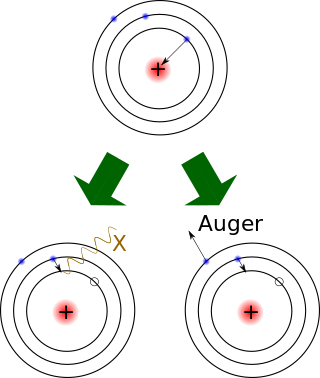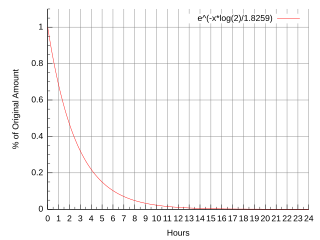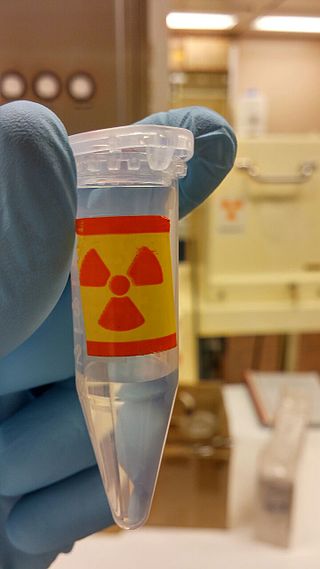
In nuclear physics, beta decay (β-decay) is a type of radioactive decay in which an atomic nucleus emits a beta particle, transforming into an isobar of that nuclide. For example, beta decay of a neutron transforms it into a proton by the emission of an electron accompanied by an antineutrino; or, conversely a proton is converted into a neutron by the emission of a positron with a neutrino in so-called positron emission. Neither the beta particle nor its associated (anti-)neutrino exist within the nucleus prior to beta decay, but are created in the decay process. By this process, unstable atoms obtain a more stable ratio of protons to neutrons. The probability of a nuclide decaying due to beta and other forms of decay is determined by its nuclear binding energy. The binding energies of all existing nuclides form what is called the nuclear band or valley of stability. For either electron or positron emission to be energetically possible, the energy release or Q value must be positive.

Positron emission tomography (PET) is a functional imaging technique that uses radioactive substances known as radiotracers to visualize and measure changes in metabolic processes, and in other physiological activities including blood flow, regional chemical composition, and absorption. Different tracers are used for various imaging purposes, depending on the target process within the body.

The positron or antielectron is the particle with an electric charge of +1e, a spin of 1/2, and the same mass as an electron. It is the antiparticle of the electron. When a positron collides with an electron, annihilation occurs. If this collision occurs at low energies, it results in the production of two or more photons.

A beta particle, also called beta ray or beta radiation, is a high-energy, high-speed electron or positron emitted by the radioactive decay of an atomic nucleus, known as beta decay. There are two forms of beta decay, β− decay and β+ decay, which produce electrons and positrons, respectively.

Electron capture is a process in which the proton-rich nucleus of an electrically neutral atom absorbs an inner atomic electron, usually from the K or L electron shells. This process thereby changes a nuclear proton to a neutron and simultaneously causes the emission of an electron neutrino.

Positron emission, beta plus decay, or β+ decay is a subtype of radioactive decay called beta decay, in which a proton inside a radionuclide nucleus is converted into a neutron while releasing a positron and an electron neutrino. Positron emission is mediated by the weak force. The positron is a type of beta particle (β+), the other beta particle being the electron (β−) emitted from the β− decay of a nucleus.
A radioactive tracer, radiotracer, or radioactive label is a synthetic derivative of a natural compound in which one or more atoms have been replaced by a radionuclide. By virtue of its radioactive decay, it can be used to explore the mechanism of chemical reactions by tracing the path that the radioisotope follows from reactants to products. Radiolabeling or radiotracing is thus the radioactive form of isotopic labeling. In biological contexts, experiments that use radioisotope tracers are sometimes called radioisotope feeding experiments.
There are 20 isotopes of sodium (11Na), ranging from 17
Na to 39
Na, and two isomers. 23
Na is the only stable isotope. It is considered a monoisotopic element and it has a standard atomic weight of 22.98976928(2). Sodium has two radioactive cosmogenic isotopes. With the exception of those two isotopes, all other isotopes have half-lives under a minute, most under a second. The shortest-lived is the unbound 18
Na, with a half-life of 1.3(4)×10−21 seconds.

Spiperone (Spiroperidol; brand name: Spiropitan(JP)) is a typical antipsychotic and research chemical belonging to the butyrophenone chemical class. It is licensed for clinical use in Japan as a treatment for schizophrenia. Additionally, spiperone was identified by compound screening to be an activator of Ca2+ activated Cl− channels (CaCCs), thus a potential target for therapy of cystic fibrosis.

Fluorine-18 (18F) is a fluorine radioisotope which is an important source of positrons. It has a mass of 18.0009380(6) u and its half-life is 109.771(20) minutes. It decays by positron emission 96.7% of the time and electron capture 3.3% of the time. Both modes of decay yield stable oxygen-18.
A gallium scan is a type of nuclear medicine test that uses either a gallium-67 (67Ga) or gallium-68 (68Ga) radiopharmaceutical to obtain images of a specific type of tissue, or disease state of tissue. Gallium salts like gallium citrate and gallium nitrate may be used. The form of salt is not important, since it is the freely dissolved gallium ion Ga3+ which is active. Both 67Ga and 68Ga salts have similar uptake mechanisms. Gallium can also be used in other forms, for example 68Ga-PSMA is used for cancer imaging. The gamma emission of gallium-67 is imaged by a gamma camera, while the positron emission of gallium-68 is imaged by positron emission tomography (PET).
In physics, electron emission is the ejection of an electron from the surface of matter, or, in beta decay, where a beta particle is emitted from an atomic nucleus transforming the original nuclide to an isobar.

MK-9470 is a synthetic compound which binds to the CB1 cannabinoid receptor and functions as an inverse agonist. The 18F-labeled version, [18F]-MK-9470, is used in research as a positron emission tomography (PET) tracer for brain imaging of the CB1 receptor.

Altanserin is a compound that binds to the 5-HT2A receptor. Labeled with the isotope fluorine-18 it is used as a radioligand in positron emission tomography (PET) studies of the brain, i.e., studies of the 5-HT2A neuroreceptors. Besides human neuroimaging studies altanserin has also been used in the study of rats.
Cardiac PET is a form of diagnostic imaging in which the presence of heart disease is evaluated using a PET scanner. Intravenous injection of a radiotracer is performed as part of the scan. Commonly used radiotracers are Rubidium-82, Nitrogen-13 ammonia and Oxygen-15 water.
Emission computed tomography (ECT) is a type of tomography involving radioactive or emissions. Types include positron emission tomography (PET) and Single-photon emission computed tomography (SPECT).

Positron emission mammography (PEM) is a nuclear medicine imaging modality used to detect or characterise breast cancer. Mammography typically refers to x-ray imaging of the breast, while PEM uses an injected positron emitting isotope and a dedicated scanner to locate breast tumors. Scintimammography is another nuclear medicine breast imaging technique, however it is performed using a gamma camera. Breasts can be imaged on standard whole-body PET scanners, however dedicated PEM scanners offer advantages including improved resolution.

Tanaproget is an investigational nonsteroidal progestin. It is a high affinity, high efficacy, and very selective agonist of the progesterone receptor (PR). Due to its much more selective binding profile relative to most conventional, steroidal progestins, tanaproget may prove to produce fewer side effects in comparison. As of December 2010, it is in phase II clinical trials in the process of being developed for clinical use as a contraceptive by Ligand Pharmaceuticals.

PET radiotracer is a type of radioligand that is used for the diagnostic purposes via positron emission tomography imaging technique.

Fluoroestradiol F-18, also known as [18F]16α-fluoroestradiol and sold under the brand name Cerianna, is a radioactive diagnostic agent indicated for use with positron emission tomography (PET) imaging. It is an analog of estrogen and is used to detect estrogen receptor-positive breast cancer lesions.














